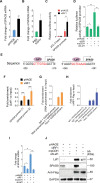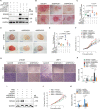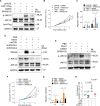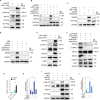Sperm associated antigen 9 promotes oncogenic KSHV-encoded interferon regulatory factor-induced cellular transformation and angiogenesis by activating the JNK/VEGFA pathway
- PMID: 32776977
- PMCID: PMC7446834
- DOI: 10.1371/journal.ppat.1008730
Sperm associated antigen 9 promotes oncogenic KSHV-encoded interferon regulatory factor-induced cellular transformation and angiogenesis by activating the JNK/VEGFA pathway
Erratum in
-
Correction: Sperm associated antigen 9 promotes oncogenic KSHV-encoded interferon regulatory factor-induced cellular transformation and angiogenesis by activating the JNK/VEGFA pathway.PLoS Pathog. 2022 Jan 7;18(1):e1010232. doi: 10.1371/journal.ppat.1010232. eCollection 2022 Jan. PLoS Pathog. 2022. PMID: 34995339 Free PMC article.
Abstract
Kaposi's sarcoma (KS), caused by Kaposi's sarcoma-associated herpesvirus (KSHV), is a highly angioproliferative disseminated tumor of endothelial cells commonly found in AIDS patients. We have recently shown that KSHV-encoded viral interferon regulatory factor 1 (vIRF1) mediates KSHV-induced cell motility (PLoS Pathog. 2019 Jan 30;15(1):e1007578). However, the role of vIRF1 in KSHV-induced cellular transformation and angiogenesis remains unknown. Here, we show that vIRF1 promotes angiogenesis by upregulating sperm associated antigen 9 (SPAG9) using two in vivo angiogenesis models including the chick chorioallantoic membrane assay (CAM) and the matrigel plug angiogenesis assay in mice. Mechanistically, vIRF1 interacts with transcription factor Lef1 to promote SPAG9 transcription. vIRF1-induced SPAG9 promotes the interaction of mitogen-activated protein kinase kinase 4 (MKK4) with JNK1/2 to increase their phosphorylation, resulting in enhanced VEGFA expression, angiogenesis, cell proliferation and migration. Finally, genetic deletion of ORF-K9 from KSHV genome abolishes KSHV-induced cellular transformation and impairs angiogenesis. Our results reveal that vIRF1 transcriptionally activates SPAG9 expression to promote angiogenesis and tumorigenesis via activating JNK/VEGFA signaling. These novel findings define the mechanism of KSHV induction of the SPAG9/JNK/VEGFA pathway and establish the scientific basis for targeting this pathway for treating KSHV-associated cancers.
Conflict of interest statement
The authors have declared that no competing interests exist.
Figures







Similar articles
-
An oncogenic viral interferon regulatory factor upregulates CUB domain-containing protein 1 to promote angiogenesis by hijacking transcription factor lymphoid enhancer-binding factor 1 and metastasis suppressor CD82.Cell Death Differ. 2020 Dec;27(12):3289-3306. doi: 10.1038/s41418-020-0578-0. Epub 2020 Jun 17. Cell Death Differ. 2020. PMID: 32555380 Free PMC article.
-
CircRNA ARFGEF1 functions as a ceRNA to promote oncogenic KSHV-encoded viral interferon regulatory factor induction of cell invasion and angiogenesis by upregulating glutaredoxin 3.PLoS Pathog. 2021 Feb 4;17(2):e1009294. doi: 10.1371/journal.ppat.1009294. eCollection 2021 Feb. PLoS Pathog. 2021. PMID: 33539420 Free PMC article.
-
Oncogenic KSHV-encoded interferon regulatory factor upregulates HMGB2 and CMPK1 expression to promote cell invasion by disrupting a complex lncRNA-OIP5-AS1/miR-218-5p network.PLoS Pathog. 2019 Jan 30;15(1):e1007578. doi: 10.1371/journal.ppat.1007578. eCollection 2019 Jan. PLoS Pathog. 2019. PMID: 30699189 Free PMC article.
-
In Vivo Models of Oncoproteins Encoded by Kaposi's Sarcoma-Associated Herpesvirus.J Virol. 2019 May 15;93(11):e01053-18. doi: 10.1128/JVI.01053-18. Print 2019 Jun 1. J Virol. 2019. PMID: 30867309 Free PMC article. Review.
-
Distinct roles of Kaposi's sarcoma-associated herpesvirus-encoded viral interferon regulatory factors in inflammatory response and cancer.J Virol. 2013 Sep;87(17):9398-410. doi: 10.1128/JVI.03315-12. Epub 2013 Jun 19. J Virol. 2013. PMID: 23785197 Free PMC article. Review.
Cited by
-
Cancer/Testis Antigens as Targets for RNA-Based Anticancer Therapy.Int J Mol Sci. 2023 Sep 28;24(19):14679. doi: 10.3390/ijms241914679. Int J Mol Sci. 2023. PMID: 37834126 Free PMC article. Review.
-
HPV E6/E7-Induced Acetylation of a Peptide Encoded by a Long Non-Coding RNA Inhibits Ferroptosis to Promote the Malignancy of Cervical Cancer.Adv Sci (Weinh). 2025 Mar;12(10):e2414018. doi: 10.1002/advs.202414018. Epub 2025 Jan 21. Adv Sci (Weinh). 2025. PMID: 39836502 Free PMC article.
-
IRF7 inhibits the Warburg effect via transcriptional suppression of PKM2 in osteosarcoma.Int J Biol Sci. 2022 Jan 1;18(1):30-42. doi: 10.7150/ijbs.65255. eCollection 2022. Int J Biol Sci. 2022. PMID: 34975316 Free PMC article.
-
Sperm-Associated Antigen 9 Promotes Influenza A Virus-Induced Cell Death via the c-Jun N-Terminal Kinase Signaling Pathway.mBio. 2022 Jun 28;13(3):e0061522. doi: 10.1128/mbio.00615-22. Epub 2022 May 31. mBio. 2022. PMID: 35638835 Free PMC article.
-
A viral interferon regulatory factor degrades RNA-binding protein hnRNP Q1 to enhance aerobic glycolysis via recruiting E3 ubiquitin ligase KLHL3 and decaying GDPD1 mRNA.Cell Death Differ. 2022 Nov;29(11):2233-2246. doi: 10.1038/s41418-022-01011-1. Epub 2022 May 10. Cell Death Differ. 2022. PMID: 35538151 Free PMC article.
References
Publication types
MeSH terms
Substances
Grants and funding
LinkOut - more resources
Full Text Sources
Medical
Molecular Biology Databases
Research Materials
Miscellaneous

